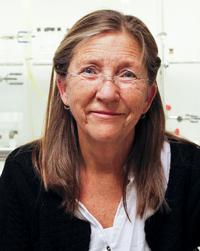Glycosphingolipids in infection and immunity
Short description
Susann Teneberg's research project aims to elucidate the roles of glycolipids in infection and immunity.
1. Microbial receptors
Treatment today is still not available for many global infectious diseases, and resistance against antibiotics is rapidly emerging. Our aim is to characterize microbe-host protein-carbohydrate interactions at a level allowing development of new anti-infection therapeutics.
2. Glycolipids presented by CD1d
NKT cells are CD1d-restricted T cells that recognize glycolipid antigens. We will further define the structural requirements for glycolipid presentation by CD1d.
3. Tumor markers
Changes in cell surface glycosylation are a general feature of cancer, and some tumor biomarkers used in the clinic are serum glycoproteins. We aim to identify new carbohydrate markers for cancer diagnostics and therapeutics.
The main objective of the project is to elucidate the roles of cell surface carbohydrates in infections and immunity.
1. Definition of microbial carbohydrate receptors
Effective treatment is today still not available for several global infectious diseases, and a situation with increasing resistance against antibiotics is rapidly emerging. The project aims at characterizing essential microbe-host protein-carbohydrate interactions to a level allowing development of new anti-infection therapeutics. We are currently studying carbohydrate receptors for Helicobacter pylori, Vibrio cholerae and enterotoxigenic Escherichia coli, and also bacterial toxins related to cholera toxin. Infections with these bacteria are the cause of numerous cases of illness and deaths worldwide, and there is an urgent need for novel treatment strategies. The ultimate goals are thus development of novel anti-infection treatments based on receptor saccharide analogues, and development of vaccines using conserved adhesins.
2. Definition of glycosphingolipids presented by CD1d
NKT cells are CD1d-restricted T cells that recognize glycolipid antigens, and play critical roles in the regulation of immune responses. We will further define the structural requirements for glycolipid presentation by CD1d, with the intention to form a basis for development of novel intervention strategies in infectious and autoimmune diseases.
3. Definition of tumor markers
One hallmark of cancer is changes in glycosylation. Many studies have focused on identifying changes in serum glycan structures, and some tumor biomarkers presently used in clinical practice are serum glycoproteins, such as CEA, CA19-9, and CA-125 for colon, pancreatic, and ovarian cancer, respectively. Our aim is to identify of novel carbohydrate markers for cancer diagnostics and therapeutics.
The three parts of the projects are intimately connected at the experimental level, and the main methods used are:
1. Identification of cell surface glycoconjugates, with focus on glycosphingolipids: Binding assays, isolation and structural characterization of glycoconjugates by mass spectrometry and NMR.
2. Flow cytometry, immunohistochemistry and immune electron microscopy for definition of the subcellular distribution of glycoconjugates.
3. Identification of microbial adhesins by using identified saccharide receptor in an affinity proteomics approach, or using deletion mutants of bacterial surface proteins.
4. High-resolution studies of protein-carbohydrate complexes: NMR and X-ray analysis of microbial proteins and carbohydrates for definition of carbohydrate binding sites.

Susann Teneberg
Principal Investigator
Affiliation:
Department of Medical Biochemistry and Cell Biology,
Institute of Biomedicine
Group members
Dani Zalem
Karel Hořejši
Farzana Yousufi Rahimi
Chunsheng Jin